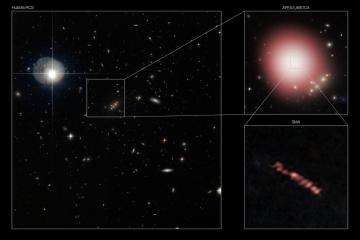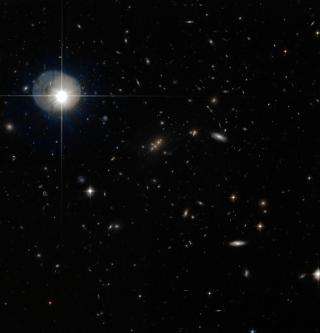Early galaxy went through 'teenage growth spurt,' scientists say (w/ Video)

(PhysOrg.com) -- Scientists have found a massive galaxy in the early Universe creating stars like our sun up to 100 times faster than the modern-day Milky Way.
The team of international researchers, led by Durham University, described the finding as like seeing "a teenager going through a growth spurt".
Due to the amount of time it takes light to reach Earth the scientists observed the galaxy as it would have appeared 10 billion years ago - just three billion years after the Big Bang.
They found four discrete star-forming regions within the galaxy known as SMM J2135-0102. Each region was more than 100 times brighter than star-forming regions in the Milky Way, such as the Orion Nebula.
They say their results, published online today (Sunday, March 21), in the prestigious scientific journal Nature, suggest that star formation was more rapid and vigorous in the early Universe as galaxies went through periods of huge growth.
The findings, funded by the Royal Astronomical Society and the Science and Technology Facilities Council, provide a unique insight into how stars formed in the early Universe, the scientists added.
Lead author Dr Mark Swinbank, in the Institute for Computational Cosmology, at Durham University, said: "This galaxy is like a teenager going through a growth spurt. If you could see it today as an adult you'd find the galactic equivalent of the football player Peter Crouch.
"We don't fully understand why the stars are forming so rapidly but our results suggest that stars formed much more efficiently in the early Universe than they do today.
"Galaxies in the early Universe appear to have gone through rapid growth and stars like our sun formed much more quickly than they do today."
The scientists estimate that the observed galaxy is producing stars at a rate equivalent to 250 suns per year.

The findings support earlier research led by Durham University. In 2009 Durham scientists found that a galaxy - called MS1358arc - was forming stars more rapidly than expected when it was observed as it would have appeared almost 12.5billion years ago.
SMM J2135-0102 was found using the Atacama Pathfinder Experiment (APEX) telescope, which is operated by the European Southern Observatory (ESO). Follow-up observations were carried out by combining the natural gravitational lens of nearby galaxies with the powerful Submillimeter Array telescope based in Hawaii to magnify the galaxy even further.
Dr Swinbank added: "The magnification reveals the galaxy in unprecedented detail, even though it is so distant that its light has taken about 10 billion years to reach us.
"In follow-up observations with the Submillimeter Array telescope we've been able to study the clouds where stars are forming in the galaxy with great precision."

Carlos De Breuck, a co-author of the paper, from ESO, said: "The star formation in this galaxy's large dust clouds is unlike that in the nearby Universe.
"However, our observations suggest that we should be able to use underlying physics from the densest cores in nearby galaxies to understand star birth in these more distant galaxies."
More information: Intense Star-Formation within Resolved Compact Regions in a Galaxy at z=2, Swinbank, AM, et al, Nature, DOI:10.1038/nature08880
Provided by Durham University


















